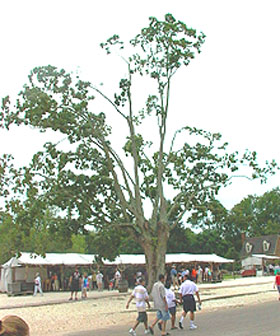Home > Health and maintenance > Damaging actions > Fertilizing under canopy
Fertilizing under the canopy
 Many
trees in managed landscapes are able to scavenge for enough elements due to
their extensive root systems.
They have access to elements applied as fertilizer to the lawn, shrubs, and
garden and need no additional fertilizer.
Many
trees in managed landscapes are able to scavenge for enough elements due to
their extensive root systems.
They have access to elements applied as fertilizer to the lawn, shrubs, and
garden and need no additional fertilizer.
Adding fertilizer that contains nitrogen (the first number on a fertilizer label) under the canopy can increase growth rate on young and medium-aged trees; this is a reasonable objective. However, increasing growth on mature trees may not be desirable. More growth means increased demands on the tree to maintain more living cells. This could actually lead to decline under certain circumstances.
Mature trees can benefit from application of certain fertilizers in instances where there is a deficiency (See: more on deficiencies). However, simply adding fertilizer around otherwise healthy mature trees may not accomplish anything. Adding fertilizer, especially nitrogen, around stressed or root damaged trees (see photo) can be harmful. Harm can occur when a tree with low reserves due to root damage or old age attempts to incorporate nitrogen into cell components.
Since this process requires energy expenditure, reserves can be lowered further. This could lead to a decline in health. Trees with low reserves have reduced ability to fight the effects of injury and pests. The tree in the photo needs to be mulched out to the edge of the canopy and pedestrians should be kept off the mulch.
When all branches on mature trees have foliage to their tips, and foliage is green, there is little reason to add fertilizer. When foliage shows deficiency symptoms, determine what element is missing and apply treatments accordingly. When you suspect a deficiency, have the soil or foliage tissue tested for important elements before prescribing a fertilizer treatment.

